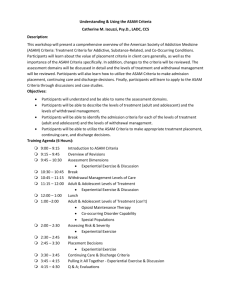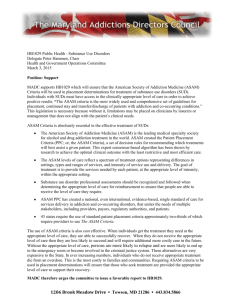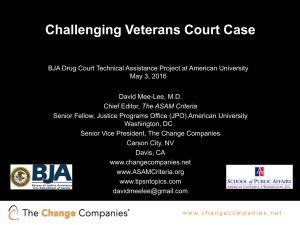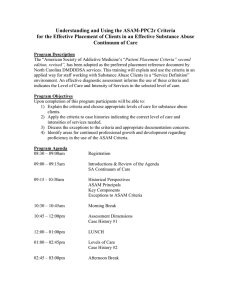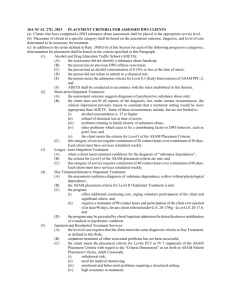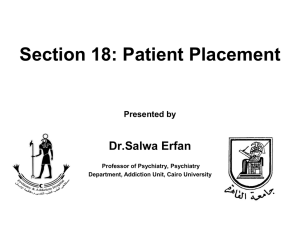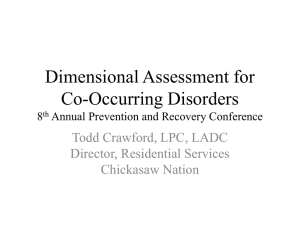Challenging Drug Court Case
advertisement
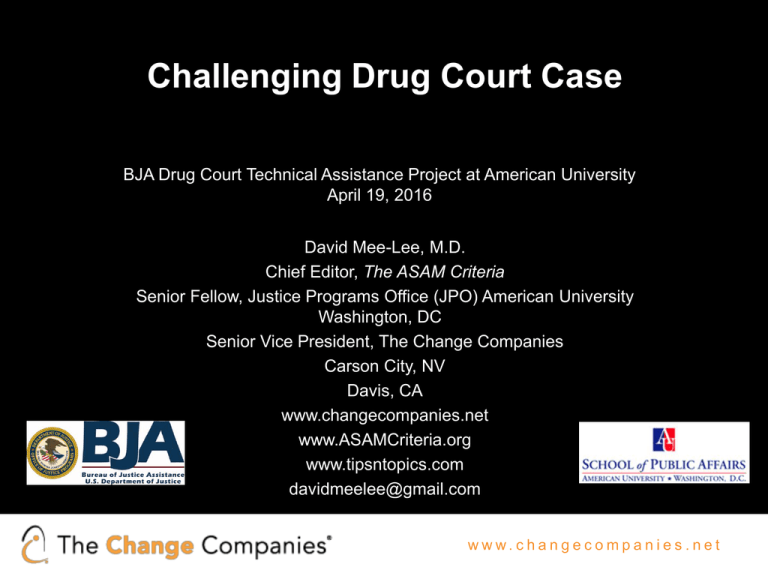
Challenging Drug Court Case BJA Drug Court Technical Assistance Project at American University April 19, 2016 David Mee-Lee, M.D. Chief Editor, The ASAM Criteria Senior Fellow, Justice Programs Office (JPO) American University Washington, DC Senior Vice President, The Change Companies Carson City, NV Davis, CA www.changecompanies.net www.ASAMCriteria.org www.tipsntopics.com davidmeelee@gmail.com w w w. c h a n g e c o m p a n i e s . n e t Reasons for this Challenging Case • My colleague and I have been listening in on Dr. Mee-Lee’s webinars and have been learning different ways to articulate cases to the drug court team, finding it quite useful when presenting the needs of individualized treatment. • This particular client came to mind because she has been on the program 16 months (typically can be complete in 12 months) and has not yet been able to move past Phase I. • As it stands now, in our drug court program there are 3 phases and 4 levels of treatment; she is currently in Level II. In order to graduate the participant must have at least 120 days clean. w w w. c h a n g e c o m p a n i e s . n e t Questions 1. Where should my focus be with this client if she is to be successful in this drug court program? 2. Can someone with psychosis be successful in a drug court program? 3. Is there such thing as too much treatment? And where does the line get crossed? 4. What might we be overlooking? w w w. c h a n g e c o m p a n i e s . n e t Demographics • Client is 38-year-old Caucasian/White (Self-described as "White") female who is divorced and has 4 children ages 21, 13, 9, and 5. • Unemployed, with no intentions to work at this time and recently approved for SSI. • Currently resides at violence protection women’s shelter. • In December, 2014, client referred to county drug court following witness tampering charge given to her during her son’s sentencing hearing. Her son remains incarcerated. • Client raised in Georgia, now residing in New Hampshire due to charges, claims Vermont is where she would like to be, and describes herself as a believer in God. • Reports feeling “proud” that “my children were raised as Christians.” She currently does not attend church. • Client dropped out of high school in 11th grade when she gave birth to her son; has GED. • Unable to drive due to her seizure disorder. w w w. c h a n g e c o m p a n i e s . n e t Key Findings • • • • • • • • • This writer/clinician has been working with client since December 2015, has had 5 one-hour individual sessions and facilitated 4 three-hour IOP sessions at which client was present. Over course of this time, client has had 3 positive urine screens (1 for codeine/morphine [01/21/2016], 2 for alcohol [12/21/2015 & 01/11/2016]). All of which she declined use, placing blame on eating an everything bagel and drinking from a universal pitcher at the shelter she resides. On 01/15/2016, client found out she was pregnant while at a checkup. Client had sleep study 02/01/16-02/05/16 to observe for epilepsy; it was found that her seizure activity was most likely psychogenic in nature & not epileptic. Client decided to terminate her pregnancy on 02/08/16. Client voluntarily checked herself into inpatient psychiatric hospital on 3/14/16 because of suicidal ideation and started drinking to “avoid using [heroin].” She discharged herself in fear of losing her housing on 3/21/2016. She began having auditory & visual hallucinations and checked herself back into the hospital on 3/25/2016 and again discharged herself on 3/30/16. Since this date she has drank on 2 more occasions, self admittedly to “get rid of the hallucinations.” Client reports “the only positive thing right now is that I’m not using[heroin].” Aware that she can become extremely anxious, desperate, and escalated when upset. w w w. c h a n g e c o m p a n i e s . n e t Background • In February 2015 client suffered her first reported seizure on the Drug Court program, which led to a head injury. • Head injury resulted in loss of her ability to taste and smell. She appeared to struggle reading and comprehending written material post head injury. • Client reports she first used cocaine at age 23 and opioid use at age 32. Also has a history of amphetamine and gabapentin abuse within the last year. • Client is currently on several medications: Buprenorphine, Sertraline, Hydroxyzine, Seroquel, Topomax, Gabapentin. • At her most recent stay in hospital she was given diagnoses of F33.3 Major Depressive Disorder, with psychotic features, recurrent; F11.20 Opioid Use Disorder, Severe, on Maintenance therapy; F10.10 Alcohol Use Disorder, mild; F32.2 PTSD; F17.200 Tobacco Use Disorder, severe; Seizure disorder, Hepatitis C (untreated), TBI. Client displays Cluster C personality disorder traits, more specifically dependent. w w w. c h a n g e c o m p a n i e s . n e t Background (cont.) • • • • • • • Client’s 2 youngest children were adopted by open adoption Summer 2015. She has had constant contact with her son who was incarcerated to the point of speaking with him every day, and blaming herself for his incarceration, saying on many occasions that she should be the one in prison for five years, not him. Her oldest son remains incarcerated and unable to make contact with him due to her charges. She has partial custody of her second child and able to see her on weekends. Client self-reported having to drink in order to succumb to her child’s father sexually in order for him to allow the visitation. Client reports having A/V hallucinations during past pregnancies starting in 2010. Approximately a year ago, she was involved in a relationship with a man who was in recovery. Client moved in with the man shortly after relationship began, leaving her sober living environment. Client reports the man began to sexually abuse her regularly. Client able to leave relationship & resided with ex mother-in-law for a time. This was catalyst for client to seek additional outpatient counseling with a trauma specialist. w w w. c h a n g e c o m p a n i e s . n e t Background (cont.) • Client was seeing a trauma informed therapist twice a week from July 2015 to early March. She reports having to drop her services due to insurance changes and described this therapist as her “best friend.” Client has referred to treatment providers prior to drug court as “friends” and “family.” • Client currently attends a 1 hour trauma informed peer support group each week. Client sees counselor at Medication-Assisted Treatment (MAT) clinic 1-2 times/week. Client sees a case manager at least once a week through drug court. • Client sees this writer/clinician once weekly for individual and attends 2-three hour drug court groups weekly. • Other drug court obligations are 5 meetings of self-help groups weekly and 5 random UA screenings weekly. • Client’s GAIN assessment from Dec. 2014 stated: reported a lifetime history of being beaten, sexual abuse, emotional abuse; and scored in the high range of the lifetime General Victimization Scale. w w w. c h a n g e c o m p a n i e s . n e t Formulation • Client has significant mental health and personality disorder symptoms. • Stressors of being on a drug court program seem to have been detrimental to client’s state. This supported by progression of her seizure activity and TCU CESTs provided throughout her time on drug court. (TCU CJ Client Evaluation of Self and Treatment (TCU CJ CEST) records offender ratings of the counselor, therapeutic groups, and the program in general) • Client has poor boundaries that appear to not have been supported by other professionals; or this seems to be case from what client has reported and her perspective of professionals. • This clinician has good/healthy boundaries and client has said several times “I didn’t know if this was going to work out between us”, which seems to play into the lack of trust client appears to have in this developing therapeutic relationship. • It seems that client is involved in too many services which appear to be enabling client’s dependent personality traits. w w w. c h a n g e c o m p a n i e s . n e t Interventions and Plans • This clinician has tried to provide drug court and judge information from the start of working with client to support her in finding alternative treatment for client given her mental health status even before the episode of psychosis was present. • Recently this clinician was able to formulate a plan of reducing amount of meetings and treatment groups client is required to do. • This clinician also verified with case manager that client would not lose her housing at the shelter if she sought inpatient treatment for a longer period of time. Client was referred to inpatient treatment on 4/12/16. w w w. c h a n g e c o m p a n i e s . n e t Reasons for this Challenging Case • My colleague and I have been listening in on Dr. Mee-Lee’s webinars and have been learning different ways to articulate cases to the drug court team, finding it quite useful when presenting the needs of individualized treatment. • This particular client came to mind because she has been on the program 16 months (typically can be complete in 12 months) and has not yet been able to move past Phase I. • As it stands now, in our drug court program there are 3 phases and 4 levels of treatment; she is currently in Level II. In order to graduate the participant must have at least 120 days clean. w w w. c h a n g e c o m p a n i e s . n e t Questions 1. Where should my focus be with this client if she is to be successful in this drug court program? 2. Can someone with psychosis be successful in a drug court program? 3. Is there such thing as too much treatment? And where does the line get crossed? 4. What might we be overlooking? w w w. c h a n g e c o m p a n i e s . n e t Clarifying Questions 1. For what diagnosis or diagnoses was the client "recently approved for SSI"? Was it for a psychosis mental health diagnosis or seizure disorder or both or something else? 2. Were the client’s auditory and visual hallucinations time-wise, related to drinking or drugging? Or did they occur during significant periods of being alcohol and other drug abstinence? 3. Do you know the longest time she has ever been abstinent, or better still in recovery and sober? Did she have any mental health signs and symptoms during the time of abstinence or sobriety? w w w. c h a n g e c o m p a n i e s . n e t Clarifying Questions 4. Does the client believe she has an addiction illness? Does she think she has a mental illness and if so, what is the diagnosis she believes she has? Does she think she has addiction AND mental illness, either or both? 5. What were the circumstances of the Feb., 2015 seizure? Was she in a clinical setting or at home? Had she been drinking and could she have had a withdrawal seizure? Was she intoxicated or recently using substances at the time of the seizure? 6. Is there a Mental Health Court or a Co-Occurring Disorders Court available? Or is there only a Drug Court available? w w w. c h a n g e c o m p a n i e s . n e t INDIVIDUALIZED, CLINICALLY & OUTCOMES-DRIVEN TREATMENT ASAM Principles of Addiction Medicine 5th Edition, 2014 w w w. c h a n g e c o m p a n i e s . n e t The ASAM Criteria Multidimensional Assessment 1. Acute Intoxication and/or Withdrawal Potential 2. Biomedical conditions and complications 3. Emotional/Behavioral/Cognitive conditions and complications 4. Readiness to change 5. Relapse/Continued Use/Continued Problem potential 6. Recovery Environment The ASAM Criteria pp. 43-53 w w w. c h a n g e c o m p a n i e s . n e t Criminogenic Factors/ASAM Criteria Dimensions Criminogenic Factors • Antisocial values, attitudes, behavior, personality ASAM Criteria Dimensions • Criminal/deviant peer association • Substance abuse • Dimension 6 • Dysfunctional family relations • Dimensions 3, 4 and 6 • Dimensions 1, 4, 5, 6 • Dimension 6 w w w. c h a n g e c o m p a n i e s . n e t Biospychosocial Treatment Treatment Matching - Modalities • Motivate - Dimension 4 • Manage – All Six Dimensions • Medication – Dimensions 1, 2, 3, 5 - MAT • Meetings – Dimensions 2, 3, 4, 5, 6 • Monitor- All Six Dimensions w w w. c h a n g e c o m p a n i e s . n e t The ASAM Criteria Treatment Levels of Service 0.5 Early Intervention 1 Outpatient Treatment 2 Intensive Outpatient and Partial Hospitalization 3 Residential/Inpatient Treatment 4 Medically-Managed Intensive Inpatient Treatment The ASAM Criteria pp. 112 -117 w w w. c h a n g e c o m p a n i e s . n e t Level 0.5 and OTS Level 0.5: Early Intervention Services - Individuals with problems or risk factors related to substance use, but for whom an immediate Substance -Related Disorder cannot be confirmed Opioid Treatment Services (OTS) - Criteria for Opioid Treatment Program (OTP) (methadone); antagonist meds (naltrexone) and Office-Based Opioid Treatment (OBOT) - buprenorphine The ASAM Criteria pp. 179 -183; 290 -298 w w w. c h a n g e c o m p a n i e s . n e t Detoxification Withdrawal Management Services for Dimension 1 Level 1-WM - Ambulatory Withdrawal Management without Extended On-site Monitoring Level 2-WM -Ambulatory Withdrawal Management with Extended On-Site Monitoring The ASAM Criteria pp. 132 -143 w w w. c h a n g e c o m p a n i e s . n e t Withdrawal Management Services for Dimension 1 (continued) Level 3.2- WM- Clinically-Managed Residential Withdrawal Management Level 3.7- WM - Medically-Monitored Inpatient Withdrawal Management Level 4-WM - Medically-Managed Inpatient Withdrawal Management The ASAM Criteria pp. 132 -143 w w w. c h a n g e c o m p a n i e s . n e t Level 1 and 2 Services Level 1 Outpatient Treatment Level 2.1 Intensive Outpatient Treatment Level 2.5 Partial Hospitalization The ASAM Criteria pp. 184 -218 w w w. c h a n g e c o m p a n i e s . n e t Level 3 Residential/Inpatient Level 3.1- Clinically-Managed, Low Intensity Residential Treatment Level 3.3 - Clinically Managed PopulationSpecific High Intensity Residential Treatment (Adult Level only) The ASAM Criteria pp. 222 -243 w w w. c h a n g e c o m p a n i e s . n e t Level 3 Residential/Inpatient (cont.) Level 3.5- Clinically-Managed, Medium/High Intensity Residential Treatment Level 3.7- Medically-Monitored Intensive Inpatient Treatment The ASAM Criteria pp. 244 -279 w w w. c h a n g e c o m p a n i e s . n e t Level 4 Services Level 4 Medically-Managed Intensive Inpatient The ASAM Criteria pp. 280 -290 w w w. c h a n g e c o m p a n i e s . n e t Focus Assessment and Treatment What Does the Client Want? Does client have immediate needs due to imminent risk in any of six dimensions? Conduct multidimensional assessment The ASAM Criteria p 124 w w w. c h a n g e c o m p a n i e s . n e t Focus Assessment and Treatment (cont.) DSM-5 diagnoses? Multidimensional Severity/LOF Profile Which assessment dimensions are most important to determine Tx priorities The ASAM Criteria p 124 w w w. c h a n g e c o m p a n i e s . n e t Focus Assessment and Treatment (cont.) Specific focus/target for each priority dimension What specific services needed for each dimension What “dose” or intensity of these services needed The ASAM Criteria p 124 w w w. c h a n g e c o m p a n i e s . n e t Focus Assessment and Treatment (cont.) Where can these services be provided in least intensive, but “safe” level of care? What is progress of Tx plan and placement decision; outcomes measurement? The ASAM Criteria p 124 w w w. c h a n g e c o m p a n i e s . n e t DSM-5 diagnoses? Multidimensional Severity/LOF Profile Which assessment dimensions are most important to determine Tx priorities Specific focus/target for each priority dimension What specific services needed for each dimension What “dose” or intensity of these services needed Where can these services be provided in least intensive, but “safe” level of care? What is progress of Tx plan and placement decision; outcomes measurement? The ASAM Criteria p 124 w w w. c h a n g e c o m p a n i e s . n e t Resources www.tipsntopics.com www.ASAMCriteria.org www.changecompanies.net w w w . c h a n33 gecompanies.net w w w. c h a n g e c o m p a n i e s . n e t w w w. c h a n g e c o m p a n i e s . n e t David Mee-Lee, M.D. Senior Vice President The Change Companies Carson City, NV www.changecompanies.net www.ASAMCriteria.org www.tipsntopics.com davidmeelee@gmail.com Justice Programs Office justice@American.edu Join us Wednesday, April 27th at 11am Eastern for the next session entitled “How Do We Get There from Here?” https://bja-au.webex.com/bjaau/onstage/g.php?PRID=a6642d1af8e20bd689ac7433ee634daf These materials have been prepared under the auspices of the Bureau of Justice Assistance (BJA) Drug Courts Technical Assistance Project at American University, Washington, D.C. This project was supported by Grant No. 2012-DC-BX-K005 awarded to American University by the Bureau of Justice Assistance. The Bureau of Justice Assistance is a component of the Office of Justice Programs, which also includes the Bureau of Justice Statistics, the National Institute of Justice, the Office of Juvenile Justice and Delinquency Prevention, and the Office for Victims of Crime. Points of view or opinions in this document are those of the authors and do not represent the official position or policies of the U.S. Department of Justice. w w w. c h a n g e c o m p a n i e s . n e t
